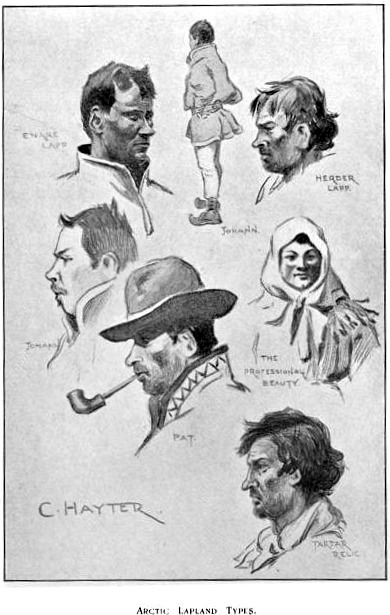Love Laplander-style requires thawing frosty relations--with lots of brandy and boiled meat.

Picture from Charles John Cutcliffe Wright Hyne's Through Arctic Lapland (1898)
The first days of September summon the Lappish hunter to his yearly ritual. He puts on reindeer-skin coat and cap (camouflage that serves to fool his quarry) and searches out a copse of pine trees to use as a place of ambush. Once situated, he bellows lustily. In sight there eventually wanders a reindeer whose curiosity has gotten the better of it. Arriving to discover the source of the noise so like the one it itself makes, the creature discovers instead that its fate is sealed. The hunter flings his weapon--an arrow, a spear, sometimes a stone--and it strikes fatally home.
"It is well known that the wild reindeer was among the game hunted by paleolithic man," writes Berthold Laufer in The Reindeer and its Domestication (1917). "There is no evidence that he ever attempted to domesticate the animal."
Laplanders these days go by the more politically correct ethnonym, Saami.
A similar knack for deception the Lappish man brings to a hunt of another sort. Should a woman turn his head, he shows no overt signs of affection. Rather, he circles round her, joking and teasing, until he observes, or thinks he observes, a glimmer of interest on her part. This cues him to carry his deception further. He pays a secret visit to her father to discuss the matter over brandy. As the liquor warms him, he warms to the subject of his supreme eligibility as a husband.
A favorable response from the father prompts the suitor to move to the next stage of the game. His aunts and uncles, mother, father, brothers and sisters he commands to form a procession and directs them to the hut of his intended. They bear her trinkets and treats, while he hides in the forest to bide his time.
Inspiration for this post comes from Thomas Thomson's 1813 book, Travels in Sweden, during the autumn of 1812.
Startled to discover that this procession has come in her honor, the object of the hunter's affection retreats to a back bedroom, leaving her father to deal with the situation. He invites the suitor's father in; not long thereafter brandy again flows. The elixir fuels a bout of intense negotiations. Once the two heads of household come to terms, the woman's father throws his home open to the rest of the retinue to celebrate the match. Women carry in plates of kappi (cheese cured in a reindeer bladder) and round, fragrant loaves of bread into which the forest itself has has been kneaded.
The dough for this Lappish specialty consists of barley flour and ground fir-tree bark.
Others bring household items and silver coins. These gifts they place on a reindeer skin to display to the bride's family.
"They informed me that it is impossible to conceive the splendor of the Aurora Borealis in those regions," recounts James Monroe Buckley in The Midnight Sun, the Tsar and the Nihilist: Adventures and Observations in Norway, Sweden and Russia (1886). "Nevertheless they confess that, long before the three months' night ends, a dull stupor come over them, broken only by an intense longing for the first appearance of the sun."

Picture from Giuseppe Acerbi's Travels through Sweden, Finland, and Lapland, to the North Cape, in the years 1798 and 1799 (1802)
The settlement reached, both the bride- and groom-to-be emerge from their respective hiding places. She tiptoes from her bedroom; he steals in from the woods. They sit shyly together amidst the laughing, cheering company, who gather round a large cloth to await the signal to fall upon the cheese, salted meat, and bowls of fermented milk heaped on it.
From The Hotel St. Francis Cook Book (1919): "Reindeer should be hung up for a least two weeks before being cooked, otherwise it will be very tough. The meat is very good, and easily prepared. Salt and pepper the chops, roll in olive oil, and broil; or fry in frying pan, in the same manner as any other kind of cop or steak. Serve with maitre d'hôtel, or some fancy meat sauce."
Yet this array of victuals is only an entree. The main course features reindeer meat enough for each guest to receive one-and-a-half pounds, a portion mandated by tradition. This meat the women boil in pots and place on a another large cloth called a
walmal. Its fat they skim and serve in basins. The bride- and groom-to-be are given the choicest bits. These they spear with sharpened knives and dip in the fat, relishing every bite. They then retire to bed fully clothed, in accordance with custom. Her family and his they leave to sleep off their surfeit.
Compared to the extravagance of the betrothal feast, the wedding itself is a spare, almost furtive affair. The banns are published once, and the ceremony is performed only after the groom's kin have departed. This no doubt seems something of an anticlimax; but in the harsh arctic region these families inhabit, joy, like summer, is fleeting. Indeed, a Lapp of luxury does not long survive, and is therefore not soon found.

